Toys are supposed to be fun for horses. So what happens if your horse doesn’t play with toys and enrichment? Are you doing something wrong? When your horse ignores toys, is there something wrong with them? Relax: It’s normal for horses to sometimes ignore enrichment or not play with toys. Here are the five most common reasons that your horse might not use their toys, and what you can do to help them get more fun out of enrichment.
When your horse doesn’t play with toys
Why is it important to know why your horse doesn’t play with toys?
Because toys are important for horses. They aren’t just for play – horse toys, puzzles, and special activities get your horse using their body and mind in natural ways.
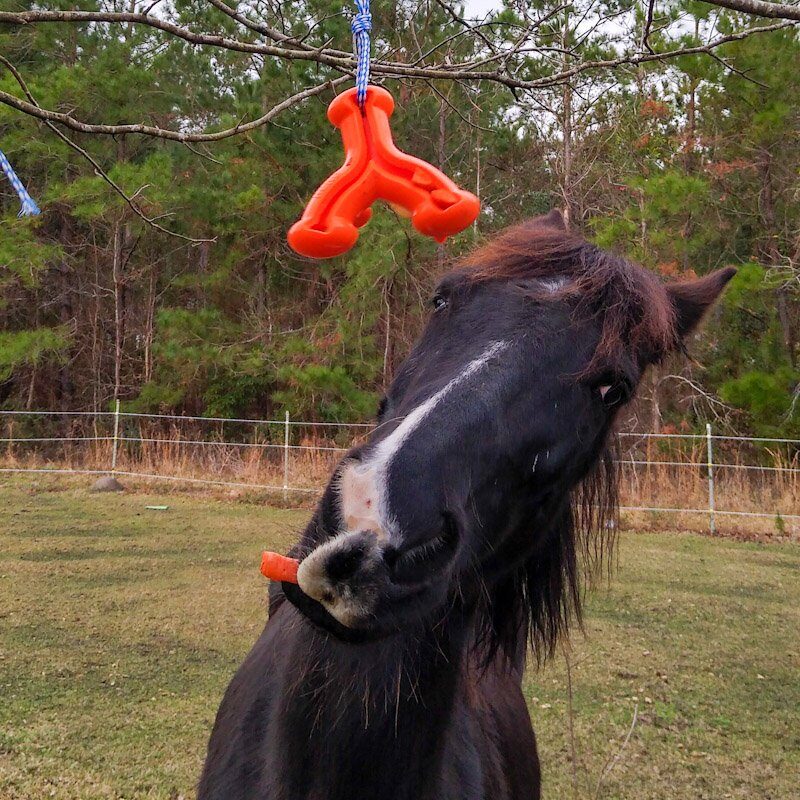
Toys are enrichment for horses. There’s more to enrichment than just toys, but they’re a big part of keeping your horse happy and free from boredom. Most horses living a modern lifestyle with limited space, stall time, and routine built around humans need enrichment items for best mental and physical health.
So if your horse won’t play with any toys, it’s important to find out why. Horses who won’t or can’t use toys and enrichment are missing out on all their benefits. If you can identify why your horse isn’t using their toys, you can help them get the most out of equine enrichment.
Here are the most common reasons that your horse ignores toys.
1. Your They Don’t Understand What Toys Are
What it looks like:
You offer a toy and your horse acts like it’s not even there.
For other kinds of enrichment, including activities like sensory walks, they don’t show curiosity or interest in the activity.
What’s happening?
It can be discouraging to give your horse a toy or set up a special activity only for them to completely ignore it. But this is surprisingly common when horses don’t understand what enrichment is.
Many horses go for years – sometimes their whole life – without enrichment. When you offer toys, puzzles, or games to a horse for the first time, they may have no idea what to do.

Your horse may ignore enrichment because they haven’t learned that they can do anything with the new toy – it’s just another piece of furniture, like an empty bucket.
The Fix
You’ll need to teach your horse what enrichment items are, starting from the ground up.
Take it back to the very basics. Food-related enrichment is a good starting place, since horses love treats. Use very easy toys like forage boxes or cardboard carton puzzles. Introduce new ways to eat, like hay nets from new locations or differently shaped bowls.
Your horse will start to develop more curiosity and interest. Then, you’ll be able to introduce more challenging puzzles and toys, including ones that don’t use food.
2. Your Horse Ignores Toys that Are Too Challenging
What it looks like:
Your horse messes with a toy or puzzle for a little while, but doesn’t seem able to solve the puzzle/get the food/use the toy the intended way.
After a few moments, they give up and start ignoring the toy.
What’s happening?
Your horse either gave up after being unable to figure out their toy, or guessed that it would take more effort and time than they want to put in.
Horses can calculate potential payoff versus difficulty. They can also feel frustration. Toys and other enrichment take skill to learn, and your horse might be ignoring their toys because they don’t have the skills needed to use the toy.
Those skills can be physical, like being coordinated enough to use a ball or pick treats out of a swinging treat feeder. They can also be mental, like figuring out how to open an egg carton to get the goodies inside.
The Fix
To help your horse enjoy their toys, lower the difficulty level. Make your horse’s toys and puzzles very simple to build their skills and interest.
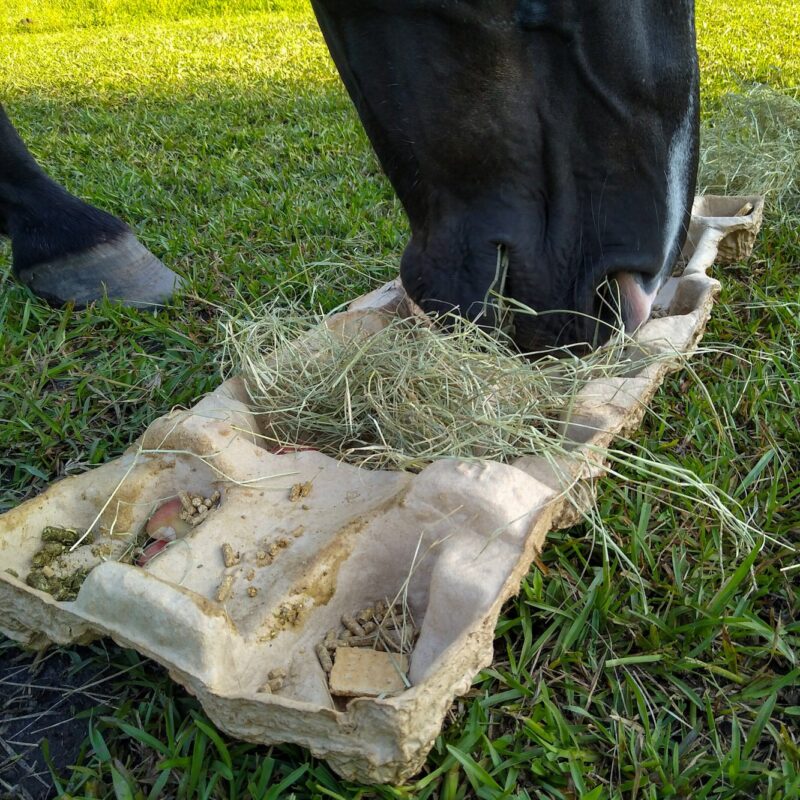
You can add more holes to your canister feeder toys or hang your swinging toys a little lower for easier access.
At the same time, use more non-food enrichment so that your horse gets to enjoy variety without needing to use any skills. Sensory enrichment, scratching boards, and walks can help relieve boredom and help your horse’s personality bloom.
3. Your Horse Is Bored with Their Toys
What it looks like
Your horse ignores toys that they used to enjoy. They don’t seem as enthusiastic about their toys and enrichment anymore.
What’s Happening
Horses need variety and novelty just like people do. Too much of the same thing over and over can get monotonous. The result? A bored horse.

Even toys can get boring if you only use a few toys, or if your horse sees the same toy day after day.
This can even happen to toys that your horse really likes, because these are the toys that we’re most likely to overuse.
It’s especially common for horses on stall rest. These horses need lots of stall enrichment but are more prone to boredom.
The Fix
To recover your horse’s spark for their toys, increase the variety of toys you offer.

Take the overused toys out of rotation for a while, and use fresh and different items. This is the perfect time for some DIY projects so you can give your horse maximum toy variety for minimum cash.
Make sure that you’re using different kinds of toys, too. Enrichment is all about encouraging your horse’s natural behaviors, so if you tend to overuse foraging toys, try play items or sensory enrichment instead.
Calendars and schedules are great for all horse owners. Using a planner or calendar is a great way to keep you on track, so you don’t overuse a toy to the point of boredom.
4. Another Horse Is Hogging the Toys
What it Looks Like:
When horses are pastured together, one or a few horses use the toys, but your horse doesn’t.
What’s Happening
Other horses may be guarding the toys, keeping other horses from using or playing with them.
This behavior might seem mean to humans, but it’s a normal behavior for horses when they perceive scarcity. It’s called resource guarding.
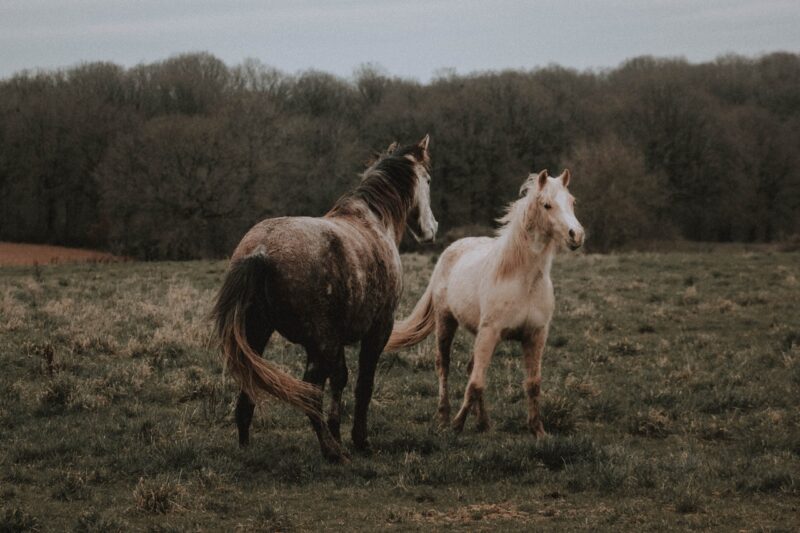
Resource guarding happens when a horse feels that something in their environment is valuable and scarce. They’ll try to keep others away from it, sometime with aggression.
Resource guarding is most common with food, but can occur around other valuable things, like toys.
The Fix
Use more toys and enrichment items in the pasture, and spread them over a large area so that a single horse can’t guard all the toys.
If you’re using food puzzles, load them with lower-value food rewards like hay pellets or cucumber chunks. Extremely tasty treats like sweet feed or apples can spark resource guarding.
If your horse is very shy or has been bullied away from toys by other horses, they may need to relearn how to love their toys. Take them out of them out of the pasture so that they can have a toy session near, but protected from, other horses.
5. Your Horse Ignores Toys Because They’re Scared
What it looks like
Your horse approaches a toy, but spooks and then avoids the toy. For non-toy enrichment items like sensory walks, they’re so keyed up and nervous that they don’t have a good time.
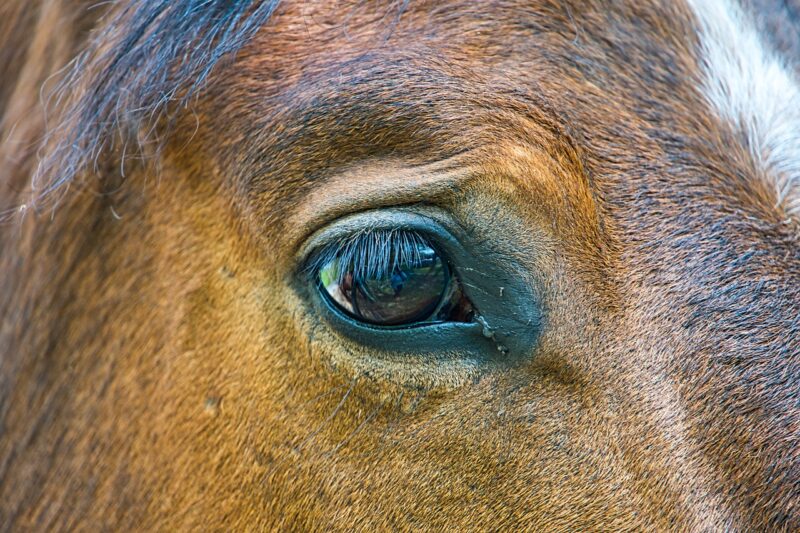
Image by Anrita1705 from Pixabay
What’s happening?
It can be discouraging if your horse seems afraid of toys, but fear of new objects is normal.
Neophobia is most common when horses haven’t had much enrichment before. It’s also more likely if your horse’s new toy moves, or makes a lot of noise.
Thankfully, if your horse is ignoring toys because they’re scared, there’s hope. With gentle exposure, they can learn to have a great time with enrichment.
The Fix
First, let the horse have choice and control over the toy. Never force or pressure the horse to interact with enrichment items by leading them to a scary item or situation, or carrying the scary item up to them.
Instead, use gradual exposure, positive training, and brave herdmates to reassure your horse that the new toy isn’t scary.
You can help your horse overcome their fear by making their toys a little less intimidating. Switch to simpler, easier toys and use more treats or food-based puzzles. As your horse figures out that toys are easy and rewarding, their confidence will grow.
6. They Like Toys, Just Not THAT Toy
What It Looks Like
Your horse ignores only a few toys but plays with others. They don’t seem scared or stumped – just not interested.
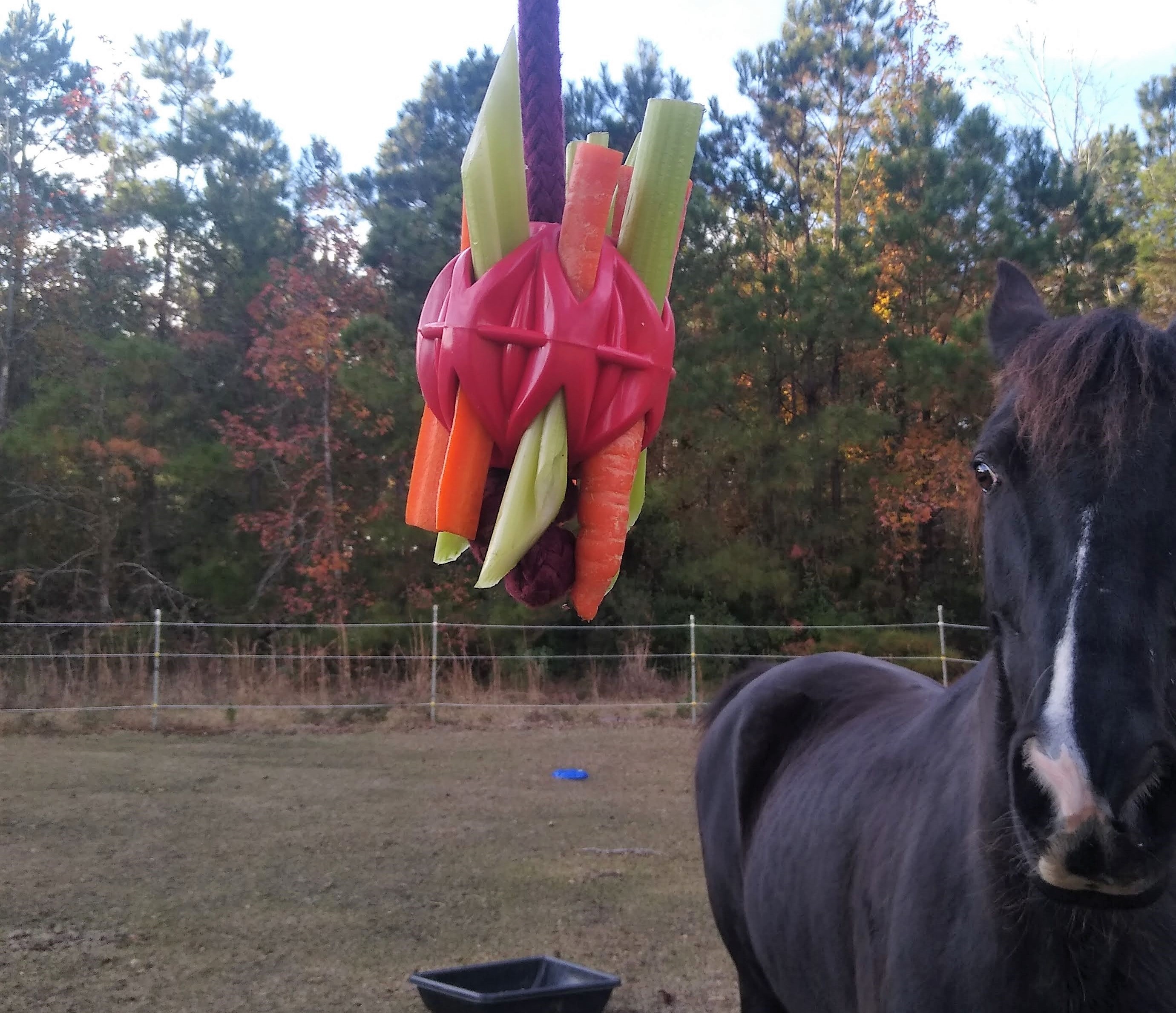
What’s happening?
Horses have preferences, just like people do! Some horses love toys that encourage rambunctious play, like plushes and giant yoga balls. Others ignore those toys but will slowly roll a treat ball around the pasture for hours.
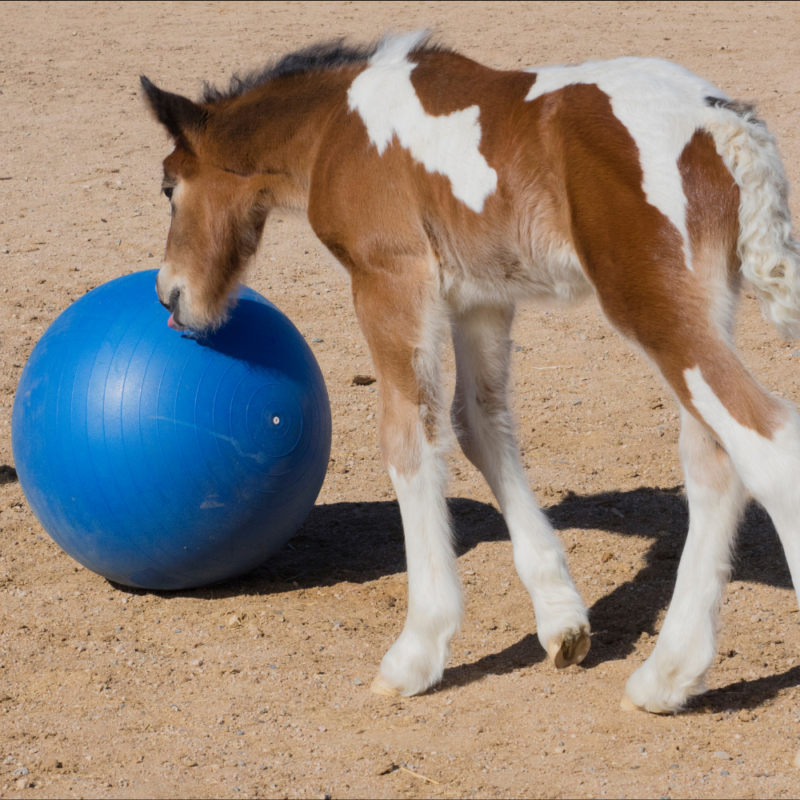
You may be giving your horse toys that don’t fit their preferences.
The Fix
When using horse enrichment, it’s important to encourage natural behaviors but also give your horse toys that they like. Thankfully, there’s a lot of variety in horse enrichment, and many ways to encourage the same behavior.
The solution, yet again, is more variety! Try different kinds of toys. Go wild on DIY items.
If you’ve been using complicated toys, swap in some simple designs. If you’ve tried toys that roll, test out toys that hang and swing. Keep using different toys with your horse until you find a few that they really love, then use them in rotation so that your horse doesn’t get bored.
The Takeaway: If Your Horse Ignores Toys, Don’t Give Up!
If your horse ignores toys, don’t give up on fun enrichment. It’s important to encourage your horse’s natural behaviors and relieve boredom with toys, puzzles, and other enrichment items.
By finding out why your horse won’t use their toys, you can problem-solve and create an enrichment routine that your horse loves!